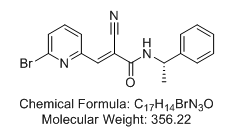|
(2E)-3-(6-Bromo-2-pyridinyl)-2-cyano-N-[(1S)-1-phenylethyl]-2-propenamide
A potent antitumor agent (in vitro IC50 = 5.6 and 3.7 µM)

OTAVAchemicals Catalogue Number: 7070707057
CAS Registry Number: 857064-38-1
Purity: 95%+ (HPLC)
Ref.: Verstovsek et al. WP1066, a Novel JAK2 Inhibitor, Suppresses Proliferation and Induces Apoptosis in Erythroid Human Cells Carrying the JAK2 V617F Mutation. Clinical Cancer Research (2008), 14, 788-796
Abstract: The discovery of an activating somatic mutation in codon 617 of the gene encoding the Janus kinase (JAK)-2 (JAK2 V617F) in patients with myeloproliferative disorders has opened new avenues for the development of targeted therapies for these malignancies. However, no effective JAK2 inhibitors are currently available for clinical use.
(E)-3(6-bromopyridin-2-yl)-2-cyano-N-(S-1phenylethyl)acrylamide (WP1066), a novel analogue of the JAK2 inhibitor AG490, significantly inhibited JAK2 and its downstream signal transducer and activator of transcription-3, signal transducer and activator of transcription-5, and extracellular signal-regulated kinase-1/2 pathways in a dose- and time-dependent manner. As a result, WP1066 concentrations in the low micromolar range induced time- and dose-dependent antiproliferative and proapoptotic effects in HEL cells. As expected, WP1066 inhibited the proliferation of peripheral blood hematopoietic progenitors of patients with polycythemia vera carrying the JAK2 V617F mutation in a dose-dependent manner.
WP1066 is active both in vitro and ex vivo and should be further developed for the treatment of neoplasms expressing the JAK2 V617F mutation. A cell-permeable AG 490 tyrphostin analog that acts as an effective STAT3 pathway inhibitor and a much more potent antitumor agent than AG 490 in inhibiting malignant glioma growth both in cultures in vitro (IC50 = 5.6 and 3.7 µM in a viability assay using U87-MG and U373-MG, respectively; no inhibition against nontumor NHA at 10 µM) and in mice in vivo. Shown to cross blood-brain barrier in mice in vivo.
DOI: 10.1158/1078-0432.CCR-07-0524
Price info:
|
1 MG |
59 EUR |
|
5 MG |
99 EUR |
|
10 MG |
129 EUR |
|
300uL of 10mM solution |
79 EUR |
|
 HOME
HOME ABOUT
ABOUT
 SERVICES
SERVICES
 PRODUCTS
PRODUCTS
 Targeted Libraries
Targeted Libraries
 Biochemicals
Biochemicals
 RESEARCH
RESEARCH
 DOWNLOADS
DOWNLOADS ORDERING
ORDERING
 CONTACTS
CONTACTS


